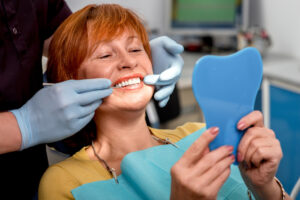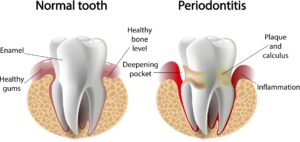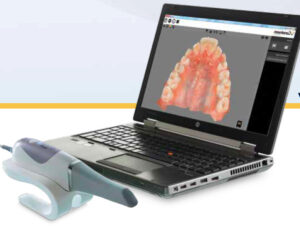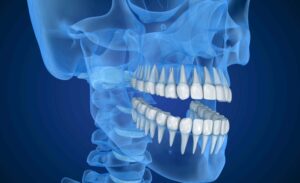Header logo
header top contact widget
Receded Gums
Misconceptions Of Oral Health
Posted on Sep 14, 2021 by William J. Claiborne, DDS MS
As a periodontal dental specialist, I have advanced skills in the treatment of gum disease and dental implants. In my specialty, I see patients who have various issues related to oral health. Some of these can be resolved with minor treatment and others require more involved procedures.
In many cases, however, a factor in the severity of certain issues occur because it was assumed the problem would resolve itself. Some patients have also assumed that certain signs or symptoms were “normal”.
The health of the mouth is largely reliant on the condition of the gum tissues. This moist, soft covering of tissues is a protective blanket for the structures underneath. Gum tissues protect the structures that support natural teeth as well as their roots.
Yet, because the gums are not visible as are teeth, it is easy to “back burner” problems. Some of these problems DO resolve on their own. However, in too many cases, what is set aside eventually requires extensive treatment; treatment that may have easily been avoided with early care.
I’d like to address some of the more common issues I see that are misconceptions…
Assuming seeing blood in the sink when brushing teeth is normal: Srubbing teeth so rigorously that they bleed is not a sign of doing a good job. This action not only wears away precious tooth enamel, it wears away the gum tissues that wrap the base of teeth.
Gums that bleed when brushing are also a symptom of periodontal (gum) disease. In addition, gum disease can cause tenderness, swelling or frequent bad breath. Without treatment, gum disease will progress further. This is why it is the nation’s leading cause of adult tooth loss.
Protect tooth enamel and gum tissues by using a soft to medium bristled toothbrush and a non-abrasive toothpaste (never substances such as baking soda). Using a swirling motion (rather than going back-&-forth), avoid applying too much pressure. Make sure that the tips of the bristles are contacting the surfaces of teeth. Hint: If you notice your toothbrush’s bristles flay outward after a month or so of use, you’re pressing too hard.
Ignoring gum recession: The gums are designed to snugly wrap the base of each tooth, serving to seal out bacteria. Although the aging process and oral dryness can shrink gum tissues, a common cause of receded gums is gum disease.
Gum recession is what causes sensitivity to hot, cold or the bristles of a toothbrush. Oftentimes, a bite of ice cream can send a jolt of pain. Even without the sensitivity, recession can leave the darker tooth root areas exposed. This leaves the tooth vulnerable to damage by oral bacteria.
Ignoring frequent bad breath: Bad breath is typically a by-product of bacteria build up. Although certain medical conditions can contribute to bad breath, keeping oral bacteria levels under control will minimize the risk of having smelly breath odor.
Saliva is what controls a significant amount of oral bacteria. However, without regular brushing and flossing, bacteria can quickly exceed what saliva is able to manage.
This is why it is important to brush twice daily and floss daily. These small tasks help to control bacteria by removing the sticky buildup of plaque. If not removed, plaque hardens into what is known as tartar. Tartar is a destructive mass of bacteria that can no longer be brushed or flossed away.
Having gum depth measurements of four and over: During regular check-ups, hygienists check gum health by gently using a probe along the base of each tooth. This is done to indicate loosening of gum tissues on the front and back sides of teeth. A good check-up will have no depth measurement higher than a three.
If the depth measures a 4 or 5 (or higher), the gums are not sealing out oral bacteria sufficiently. This may be an indication of gum disease. The higher the number, the more advanced it is.
Assuming tooth loss is normal: Some people assume tooth loss is a natural part of the aging process. This is not accurate. Adults lose teeth due to accidents, decay or (most often) gum disease.
Occasionally, a tooth that needs crowning or filling is deemed a “problem” tooth. This causes some people to want the tooth removed rather than repaired. Yet, missing tooth roots in the jaw bone triggers a process of bone shrinkage. This is known as resorption.
Resorption occurs without the stimulating presence of the tooth root. As the bone declines in height and width, neighboring teeth can also be affected. Adjacent tooth roots in areas of insufficient bone structure are at a higher risk of cavities, gum disease, and tooth breaks or fractures. Statistics show that a tooth adjacent to a missing tooth is most likely the next to be lost.
When a tooth must be removed, we recommend replacing it with a dental implant. Because an implant is positioned in the bone, it helps halt bone loss and protect the well-being of neighboring teeth.
Not reacting to spots on the tongue, lips or inside the cheek: People occasionally develop canker sores inside the mouth. These can be caused by stress or having an acidic diet. Both should go away within ten days or so.
Any spot or change inside the mouth or throat that does not resolve on its own within two weeks should be seen immediately. This may be a sign of oral cancer and may appear as a red or white spot. Or, it may cause hoarseness or difficulty swallowing. If caught early, oral cancer can be successfully treated. Acting promptly is highly important as it can lead to disfiguring treatment and be even deadly.
Assuming oral health is contained in the mouth: It has been shown that having good oral health is an advantage to having good overall health. The potent bacteria of gum disease can enter the bloodstream and cause inflammatory reactions elsewhere in the body. Research has correlated a number of serious health problems with the infectious bacteria of gum disease. These include heart disease, stroke, some cancers, Alzheimer’s disease and arthritis.
As an Asheville periodontist, I believe that adults can improve their oral health by being informed patients and committed to having a healthy smile.
A good resource on maintaining good oral health is the web site of the American Academy of Periodontology: www.perio.org (go to Patient Resources). Or, call our Asheville periodontal dental office at 828-274-9440.
How The Contours of Your Gums Can Enhance Smile’s Appearance
Posted on Aug 10, 2021 by William J. Claiborne, DDS MS
I remember the home of a beloved Great Aunt, whom I visited often growing up. One of the things that made her home so “homey” were the displays of bric-a-brac. As a youngster, I didn’t term her arrangements of china tea sets and Hummel figurines as bric-a-brac (they were “knick knacks,” to me). However, I found myself being drawn to her displays on shelves, in curios, and on tables moreso as I grew older.
To me, what was impressive about these groupings was how balanced they were. The china tea pots were centered, surrounded by carefully spaced cups and saucers. Hummel children were in playful arrays to appear as a happenstance assembly of friends.
As a Periodontist, I am now far more appreciative of how my Aunt kept such proper balance to these displays. Everything seemed so coordinated, harmonized.
As a specialist in the treatment of all stages of periodontal (gum) disease and the placement of dental implants, I am also the expert when it comes to the contours of gum tissues surrounding teeth. The gums are important to the health of your teeth as well as the appearance of a smile.
When it comes to protecting teeth, think of the gum tissues as a protective blanket. The gums cover over the under-structures of the mouth’s interior (oral cavity). If you’ll look at the base of each tooth, you’ll see that the gum tissues snugly wrap the base of each tooth. This protective seal is what prevents bacterial penetration below the gum line.
When gum tissues loosen their grip around teeth, the leading cause is gum disease. Gum disease weakens oral tissues and causes them to become inflamed. As the gums loosen, bacteria is able to work their way into the structures that support natural teeth (including bone).
When bacteria reach this level of oral structures, ridding it involves a more involved procedure than what a mere dental cleaning can combat. As it progresses, the gums become spongy and pus pockets form. Teeth loosen and may need removal. Gum disease is the leading cause of adult tooth loss.
Yet, gum tissues not only serve as a protective element of your mouth. The appearance of a smile can be greatly affected by the shape and amount of gum tissues exposed when smiling.
Balance is an element of beauty, according to studies. We are drawn to it. According to Penn State’s “Science in Our World: Certainty and Controversy”,
“Studies show that symmetrical faces are preferred and more attractive to others than people who have asymmetrical faces. Similarly shaped eyes and eyebrows, sides of the nose mouth can all fall into the symmetrical category.”
They shared findings of one study, performed over the course of two decades, that had men and women rank the attractiveness of people in photos. The study revealed:
“Men and women both overwhelmingly chose the most symmetric face. This test was an observational study, so it was only as clear and truthful as the participants of the study were. There wouldn’t really be a way to make this sort of study an experimental test, so as far as attraction goes, studies must rely on the opinions of the participants. However, the majority of the participants chose the most symmetrical faces as the most attractive ones, so it is easily said that it is true, symmetry equals attractiveness.”
http://www.livescience.com/7023-rules-attraction-game-love.html
Although “beauty is in the eye of the beholder,” symmetry seems to be a component of what humans define as beautiful and what we’re drawn to (although inner beauty is an important factor in what keeps us connected to an individual).
When a smile shows too much or too little gum tissue bordering the tops of teeth, it moves the smile line out of balance. For example, in a “beautiful” smile, the arches of gum tissues visible in a full smile are at a similar level. The amount of gum arches are in a complimentary line to teeth, rather than an amount that draws the eye. Too much gum tissue showing is referred to as a “gummy smile.”
A gummy smile is not an unattractive feature. Having one does, however, alter the appearance of a smile based on balance. For example, a diastema is a wide space between the two front teeth. It is often a hereditary trait. Although it is not unattractive feature, the eye seems drawn to that one spot rather than seeing the smile, as a whole, as a complement to other facial features. The individual may have beautiful lips or eyes, but the gap between the teeth is what is noticed as being “off.”
Quite frankly, some people are perfectly comfortable with having a gummy smile or a diastema. For them, it’s part of their personality or signature look. After all, what would Lauren Hutton, the famous model of the 70’s, have been without her diastema?
For other people, these features cause shyness, insecurity or a feeling of awkwardness. Some people try to smile with lips only. Others try to conceal a full smile with a hand. “Holding back” on a smile is a shame, especially since smiling is a proven asset to our frame of mind.
The act of smiling causes the brain to release chemicals known as endorphins. These trigger somewhat of a natural high, creating a happier mood. This has been shown to be true even when faking a smile.
Additionally, people who smile often are deemed happier, more confident and even younger. In smiling, the facial muscles pull upward and smooth out the skin to give the face a bit of a lift. Free of charge!
Another distortion in a balanced smile can be an uneven line of gum tissues, where there is more gum showing on some teeth than others. This up-and-down line of gum tissues creates a jumbled look. Again, the appeal of balance is disrupted.
In these cases, a “crown lengthening“ procedure is often advised. This is a simple procedure that alters the height of the gum tissues prior to placement of a crown (‘cap’). Not only does this provide a more flattering smile line, it protects the teeth involved while enhancing the tooth’s shape.
Another issue that impacts both appearance and the health of a tooth is gum recession. When the gums recede from the base of teeth, more sensitive and vulnerable areas of the tooth’s root are exposed. Exposure can lead to sensitivity and higher risk for bacterial penetration.
The procedure for most gum recontouring is known as a Gingivectomy. In this, our Asheville Periodontal dental office uses a dental laser. Gingivectomy is the most common procedure performed with a laser, which is used to precisely contour gingiva (gum tissue) for restorative, cosmetic, and periodontal needs.
The laser promotes rapid healing and reduces discomfort post-operatively with periodontal packing or sutures rarely needed. In the hands of a skilled periodontal specialist, laser technology also minimizes penetration depths. For minor procedures, lasers can sometimes require little or no anesthetic.
For more involved gum contouring, our Asheville periodontal office offers both oral and I.V. sedation. Oral sedation is a pill that helps patients relax. It also has an amnesiac effect, leaving most with little or no memory of treatment afterward.
I.V. sedation places the patient in a deeper sleep state, also erasing memory of the procedure. It is administered by a doctor of anesthesiology for optimal comfort and safety. In our office, this is overseen by Dr. Brad Stone, a Medical Doctor (MD) who is a board certified Anesthesiologist & Pediatric Anesthesiologist.
With both sedation options, patients are closely monitored with advanced safety equipment throughout treatment.
The health and appearance of your smile are important. It is proven that good oral health is a supportive component to your overall health. It is also shown that the appearance of a smile can add positively to an individual’s perception of “self”.
If you’re interested in improvements in the health and appearance of your smile, let’s discuss the possibilities during a consultation appointment. Call 828-274-9440. A referral is not always needed.
Arthritis? Recommit Yourself To Having Good Oral Health.
Posted on Jun 20, 2021 by William J. Claiborne, DDS MS
According to the Centers For Disease Control & Prevention (CDC), over 47 percent of American adults are living with some level of gum disease. For those age 65 and older, this figure jumps to 70 percent.
These concerning statistics are nothing to ignore. Although gum disease is so common, it increases risks that go far beyond the mouth. Over the years, research has tracked many diseases and conditions that correlate with gum disease bacteria. The inflammatory reactions triggered by these infectious bacteria have been linked to heart disease, stroke, some cancers, diabetes, preterm babies, and impotency.
Research has also shown a notably close relationship between gum disease and rheumatoid arthritis (RA). These studies have been ongoing for many years, and the findings should be concerning to all adults.
RA is a debilitating, painful disease that destroys joints. RA often emerges gradually, initially causing morning stiffness and weak, sore muscles. As inflammation from RA worsens, joints become swollen. Joints become achy and stiff most often in the fingers, wrists, elbows, hips, knees, ankles, toes and neck. Unfortunately, there is no cure for RA.
On a positive note, studies have shown that treating RA patients who have periodontal disease helps to improve RA symptoms. It is felt that this occurs because of a lighter burden of oral inflammation to the body’s immune system.
Below are some of the findings you may want to review. First, however, it’s important to understand how gum disease begins and some signs and symptoms.
In the initial stage of periodontal (gum) disease, known as gingivitis, the gums may bleed when brushing. Bad breath is more frequent and the gums may be tender or swollen. As the disease progresses, the gums turn red and may pull away from the base of some teeth.
Bad breath becomes persistent and pus pockets may form at the base of some teeth. As the infectious bacteria attack the bone structures that support tooth roots, teeth will begin to loosen and may need removal. Gum disease is the leading cause of adult tooth loss in the U.S.
In addition to the devastating damage in the mouth, the infectious bacteria of gum disease can enter the bloodstream through diseased gum tissues, causing the inflammatory triggers that activate serious health problems, such as RA.
Years ago, researchers noticed an RA-perio trait among people with rheumatoid arthritis. While RA sufferers had gum disease more often, they observed that people with gum disease tended to have RA more often.
As researchers delved deeper into the connection, it appeared that the association is much more complicated than previously thought. Findings now suggest that oral bacteria could actually be a cause of rheumatoid arthritis.
In the past, doctors felt that periodontal disease was a result of RA itself since stiff, painful hands make it challenging to maintain good oral hygiene. They also suspected that medications prescribed to treat RA could be a factor since the drugs, which suppress the immune system, inhibited the body’s ability to fight harmful oral bacteria.
Both conditions cause chronic inflammation in tissues that connect to bone with both diseases having a similar inflammatory trigger. Even more similar is the particular species of bacteria found in periodontally-diseased tissues when compared with tissues around arthritic joints. In one study, a particular pathogen associated with periodontal disease was found to activate the same destructive process of rheumatoid arthritis.
In 2017, study findings were released by Johns Hopkins University Division of Rheumatology, which noted evidence that the tissues in the mouth of a periodontally-compromised individual and the tissues of the joint in RA have a number of likenesses. Research has also shown a genetic link between the two.
Above all, these findings reinforce how oral health correlates closely to our overall health. When you consider how the presence of gum disease can significantly increase your risk for serious health conditions, having good oral health should be a priority for every American.
What can you do to lower your risks for tooth loss and contributing to (or worsening) serious health problems? Recommit yourself to thorough oral hygiene at home and having twice-a-year exams and cleanings.
If you have signs of gum disease, have treatment at your earliest convenience. Gum disease will only worsen and requires more treatment time and expense as it progresses.
Call 828-274-9440 to schedule an examination, or begin with a consultation to discuss your needs.
https://www.hopkinsrheumatology.org/2017/01/gum-disease-linked-to-rheumatoid-arthritis/
https://www.cdc.gov/oralhealth/conditions/periodontal-disease.html
https://pubmed.ncbi.nlm.nih.gov/17551378/
‘Perio’ Dental Terms
Posted on Jun 14, 2021 by William J. Claiborne, DDS MS
Occasionally, I like to remind readers of the benefits of thorough communication in dental offices, and especially in dental specialists‘ offices. When unfamiliar terms are used by the doctor or staff, it can easily leave patients in a confused state.
When patients feel less involved in their dental situation, they struggle to make decisions that are in their best interests, including decisions that can greatly affect long-term dental health.
In our Asheville periodontal dental office, we pride ourselves on providing a comfortable, respectful environment to our patients. We find that even patients who are anxious or “jittery” about dental procedures relax when they feel fully versed as to their needs, how they may have occurred, and their options in resolving the problem(s).
However, some dentists, hygienists, and dental assistants can become “immune” to the foreign nature of some terms. They tend to throw them out without realizing the terms are going askew rather than being absorbed by the patients to whom they’re communicating.
Ideally, any term or explanation that isn’t clear will prompt the patient to ask for clarity.
Below are some fairly common terms you may hear used by your dental caregivers. Hopefully, these will help you better grasp the unique situation you have that brought you to the dental chair in the first place.
PERIODONTAL (or PERIO): Defined, this means relating to or affecting the structures surrounding and supporting the teeth. Generally, however, this refers to the gum tissues in the mouth.
GINGIVITIS: This initial stage of periodontal disease causes inflammation of the gums, typically because a film of plaque (consisting of oral bacteria), has accumulated on teeth. Gingivitis is a non-destructive type of gum disease but, untreated, can progress to more serious levels that are highly destructive.
PERIODONTITIS: This inflammatory reaction is triggered by a buildup of bacteria in dental plaque. This stage of gum disease leads to a loss of tooth-supporting bone, formation of deep “pockets”, and eventually tooth loss.
PROPHY: Also known as a dental cleaning, a prophy is a treatment that involves the cleaning and polishing of tooth surfaces to control bacteria on the teeth and just below the gum line. A prophy is recommended every six months to maintain healthy gums and teeth.
BUCCAL: This is the cheek-side of teeth. For front teeth, it may also be referred to as the facial surface.
LINGUAL: The opposite of buccal, this refers to the surface of teeth that face the tongue.
MESIAL: This is the surface of a tooth that is closest to the midline of the face.
OCCLUSAL: This is the chewing surface of back teeth.
POCKETS: This is a small opening in gum tissues between the gums and the teeth where the gum should normally fit snugly against the tooth. A pocket holds bacteria, which can allow infection to penetrate below the gum line.
DEBRIDEMENT: When a buildup of plaque and calculus becomes imbedded around the gums and between teeth, a dentist or dental specialist often must remove it in order to perform a thorough oral exam.
ROOT PLANING: This is a non-surgical procedure for the removal of plaque, hardened tartar ( calculus), and/or stains from a patient’s teeth and tooth roots. This is typically performed to reach oral bacteria that has moved below the gum line.
MAXILLA: This is your upper jaw, which holds upper tooth roots. This bone is part of the skull structure and does not move.
MANDIBLE: This is the lower jaw bone, where lower teeth are held. This bone is hinged to the skull and moves up and down and slightly sideways, made possible by the temporomandibular joints (TMJ).
ARCH or RIDGE: In dentistry, this refers to the raised, gum covered “u” that supports the upper or lower teeth. For example, a “full arch of teeth” indicates a complete row of all upper or lower teeth.
Our goal is to create informed patients who are active in their care and decision-making process for having excellent dental health.
Research has shown that a healthy mouth supports a healthy body. It has proven that oral health is intricately connected to our whole health. By minimizing the level of bacteria in the mouth, you can avoid many problems associated with the teeth and gums AND give your overall health added support.
Bacteria accumulation can sneak up on you. Gum disease symptoms begin with tender gums that may bleed when brushing. The gums may become red (versus a healthy pink color) and pull away from the base of teeth. Bad breath becomes more frequent and some swelling may occur.
As it progresses, periodontal disease can cause deep, pus filled pockets to form on the gums. The gums may loosen from their grip around teeth and bad breath is persistent. Bleeding gums may occur easily; even eating may prompt bleeding.
Eventually, the bone and tissue structures that support teeth are so damaged that the foundation for teeth gives way and teeth may need to be extracted. Gum disease is the nation’s leading cause for adult tooth loss.
If gum disease exists, it will only worsen without treatment. Please contact our Western NC periodontal office to arrange a consultation or a complete examination. A periodontist specializes in the treatment of oral tissues and is your best choice for restoring a healthy mouth.
Call 828-274-9440. Let’s get you smiling confidently, and often!
Recent Posts
Categories
Archives
- September 2024
- August 2024
- July 2024
- June 2024
- May 2024
- April 2024
- March 2024
- February 2024
- January 2024
- December 2023
- November 2023
- October 2023
- September 2023
- August 2023
- July 2023
- June 2023
- May 2023
- April 2023
- March 2023
- February 2023
- January 2023
- December 2022
- November 2022
- October 2022
- September 2022
- August 2022
- July 2022
- June 2022
- May 2022
- April 2022
- March 2022
- February 2022
- January 2022
- December 2021
- November 2021
- October 2021
- September 2021
- August 2021
- July 2021
- June 2021
- May 2021
- April 2021
- March 2021
- February 2021
- January 2021
- December 2020
- November 2020
- October 2020
- September 2020
- August 2020
- July 2020
- June 2020
- May 2020
- April 2020
- March 2020
- February 2020
- January 2020
- December 2019
- November 2019
- October 2019
- September 2019
- August 2019
- July 2019
- June 2019
- May 2019
- April 2019
- March 2019
- February 2019
- January 2019
- December 2018
- November 2018
- October 2018
- September 2018
- August 2018
- July 2018
- June 2018
- May 2018
- April 2018
- March 2018
- February 2018
- January 2018
- December 2017
- November 2017
- October 2017
- September 2017
- August 2017
- July 2017
- June 2017
- May 2017
- April 2017
- March 2017
- February 2017
- January 2017
- December 2016
- November 2016
- October 2016
- September 2016
- August 2016
- July 2016
- June 2016
- May 2016
- April 2016
- March 2016
- February 2016
- January 2016
- December 2015
- November 2015
- October 2015
- September 2015
- August 2015
- July 2015
- June 2015
- May 2015
- April 2015
- March 2015
- February 2015
- January 2015
- December 2014
- November 2014
- October 2014
- September 2014
- August 2014
- July 2014
- June 2014
- May 2014
- April 2014
- March 2014
- February 2014
- January 2014
- December 2013
- November 2013
- October 2013
- September 2013
- August 2013
- July 2013
- June 2013
- May 2013
- April 2013
- March 2013
- February 2013
- January 2013
- December 2012
- November 2012
- October 2012
- September 2012
- August 2012
- July 2012
- June 2012


